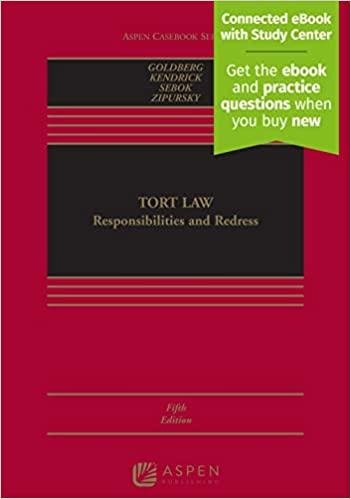Question
David was charged with arson. The prosecution attempted to prove that he burned down his failing business to get the insurance proceeds. It is uncontested
David was charged with arson. The prosecution attempted to prove that he burned down his failing business to get the insurance proceeds. It is uncontested that the fire was started with gasoline.
At a jury trial, the following occurred:
1. The prosecution calledNed, a neighbor, who testified that 15 minutes after the fire broke out, he saw a yellow Mustang speed from the scene.
2. The prosecution next calledDetective Pritchard. Pritchard testified that he checked Motor Vehicle Department records and found that a yellow Mustang was registered to David. Pritchard also testified that he observed a yellow Mustang in the driveway of David's house.
3. The prosecution then calledBrandon, the bookkeeper for David's business. Brandon testified that two months before the fire, David told Brandon to record some phony accounts receivable to increase his chances of obtaining a loan from Bank. Brandon then testified that he created and recorded an account receivable from a fictitious entity in the amount of $250,000, but that Bank denied the loan anyway. Brandon further testified that two days after the fire, David again told him to create some phony accounts receivable, but that he refused to do so.
4. The prosecution calledJessica, the night janitor at David's business, to testify that the evening before the fire, as Jessica was walking past David's office, Jessica heard a male voice say, "Gasoline is the best fire starter." Jessica knew David's voice, but because the office door was closed and the voice muffled, Jessica could not testify that the voice was David's.
Assume that in each instance, all appropriate objections were made. Should the court have admitted:
- Detective Pritchard's testimony? Discuss.
- Brandon's testimony? Discuss.
- Jessica's testimony? Discuss.
Which applies:
, 1) Relevance and Exclusionary Rule,
2) Judicial Notice,
3) Authentication and
4) the Best Evidence Rule.
Step by Step Solution
There are 3 Steps involved in it
Step: 1

Get Instant Access to Expert-Tailored Solutions
See step-by-step solutions with expert insights and AI powered tools for academic success
Step: 2

Step: 3

Ace Your Homework with AI
Get the answers you need in no time with our AI-driven, step-by-step assistance
Get Started


